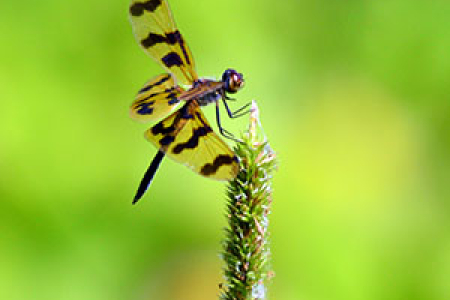Citizen dragonfly snappers wanted
The hunt is on for the best photographs of the NT’s iconic dragonfly as part of a new citizen science program that will contribute to data on the species.
Charles Darwin University aquatic ecologist and head of the School of Environment Professor Jenny Davis said that there was a lot of interest in dragonflies in Darwin with the perennial question being asked as to whether their appearance heralds the end of the wet season.
“Top Enders will tell you that the appearance of flocks of dragonflies heralds the end of the wet season, however, we have no scientific data to support this theory,” Professor Davis said.
“The dragonfly and damselfly photo competition and citizen science project is a way of giving the community an opportunity to help by collecting some data to inform this issue.”
Professor Davis, who last month launched “Identifly”, Australia’s first app to help identify some of the Northern Territory’s most spectacular flying insects, has teamed up with Territory Natural Resource Management to hold an information session alongside local photographer Caroline Camilleri who this weekend will share her expertise in capturing images of dragonflies.
“Anyone with a camera or smart device can participate in the project,” Professor Davis said.
People would need to record the location and date as they captured the photo.
“At the end of the project we will produce a timeline showing the numbers of dragonflies and damselflies recorded every day that will help us understand how dragonfly numbers change from the wet season to the dry season,” she said. “It will also tell us where Darwin’s most important spots are for dragonflies and damselflies.”
Professor Davis said people could use the Identifly app to identify dragonflies and to learn more about the species in their own backyards.
“Dragonflies are a distinctive part of the tropical biodiversity that distinguishes Darwin from all other Australian capitals,” she said.
“By using the app people can now capture an image with their smart device and then zoom in to look more closely at colour and wing markings and then compare these with the images and descriptions provided on Identifly.”
The Dragonflies and the Dry Citizen Science Project will run from mid-March to mid-July with a monthly prize for the best photo worth $500. There is also a $250 random draw prize each month.
The information and macro photography session will be held on Saturday, 25 March at the George Brown Botanic Gardens (meet at Eva’s Café) from 9am to 11am.
For more information visit the Dragonflies and Damselflies of the Top End Facebook page visit W: facebook.com/IdentiflyApp/.
